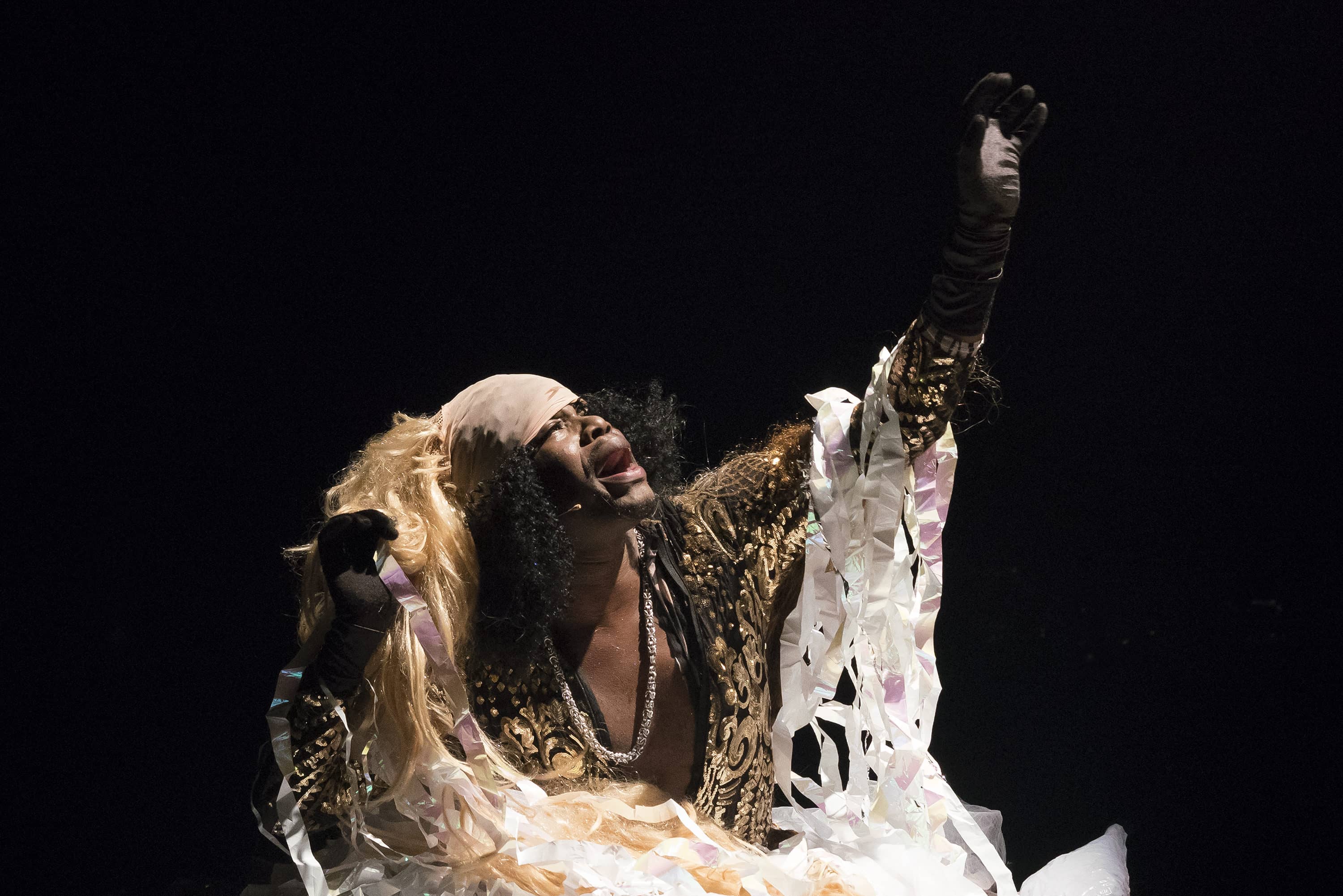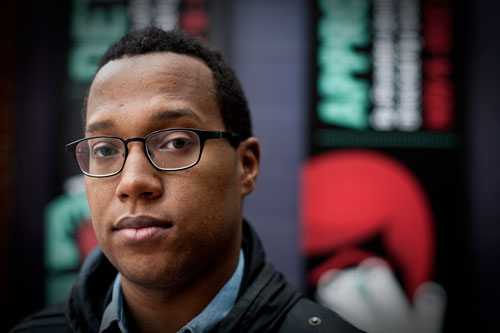Above: Jaamil Olawale Kosoko, “Séancers,” performance, 2017. Photo: Julieanne Harris
This essay is the second chapter of the series, “Pageants of Grief: Handling Loss in the works of Donald Glover, Jaamil Olawale Kosoko & serpentwithfeet.”
[R]itualistic reconstructions of the past […] attempt to bridge the gap of history through imaginative remembering. This theatre of memory represents a protean site of creative reconnection with disparate shards of the past across the wounds of history. The stage becomes a social and spiritual meeting place mediating and ultimately articulating a subterranean silent terror by means of ritualized forms.[1]
-Valérie Bada, Slavery and Silence in Ina Césaire’s “Mémoires d’Isles” and Dennis Scott’s “An Echo in the Bone” (2000)
Only being introduced to the theoretical writings and multidisciplinary performances of Jaamil Olawale Kosoko earlier this year (April 2018), something of his work glittered with familiarity. His method of curation affects a certain reverence for space and the dead, an accommodating capacity for personal and historic memory, converging to form an art practice invested in facilitating performances of mourning and the staging of grief. I was seventeen when I studied Dennis Scott’s ‘An Echo in the Bone,’ a Jamaican play housed in the form of a Nine-Night ceremony, where libation beckons the dead to recall themselves in the mouths of the living, in a collective effort of memory as to reimagine and reconcile troubling pasts. In the works of Kosoko and Scott, the stages on which grief and memory are poured and performed treat the traumas of the past (in all its layers, between the recent and the historic) as wounds in need of recognition, reconfiguration, and revision. The presence and operation of the voice becomes of particular interest in Kosoko and Scott’s work, as a tool to address repressed historical silences, “faint echoes in the bone, deep within, which must now be recovered and made audible,”[2] in addition to restoring agency to the unspoken testaments of those killed before their time. The pouring of libation as an act of clearing the throats of the dead so that they may speak uninterrupted and unfiltered truths; such manifestations of the voice serve to demystify those projections of fear and desire, those prejudiced inventions that shroud the black body in myths of criminality and disposability.
Voice is not an organic part of the human body; it’s coming from somewhere in between your body. Whenever we talk to another person, there is always this minimum of ventriloquist effect as if some foreign power took possession – […] a voice in its obscene dimension.[3]
In his performance practice, Kosoko takes on the role of a medium, channeling voices of the past, mostly drawing from sources of black revolutionary thinkers and activists. Subverting and reimagining a conventional tool of academic writing, the acts of quotation and citation become a performative invocation of the ancestral voice. Of course, some of Kosoko’s sources are still very much alive but, it is more a matter of drawing on the words and energies available to us by those who have come before us; the ancestral spirit is not bound to linear dimensions or experiences of time. Bringing together voices of the recent and historic pasts and allowing them to slip through his mouth, Kosoko breaks down the temporal limits of his spaces. Where a quotation is no longer a tool to carelessly harvest voices from the dead but to give them new life in the form of spells and incantations; to magically resurface them, so as not to condemn them to the ground or the archives but, instead, to mourn them by way of radical remembering
One of Kosoko’s most startling invocations of another’s voice can be seen in a micro-performance, stemmed from his work ‘Séancers,’ which took place as part of his lecture, “White State | Black Mind: Black Fugitivity in the Wake of Loss,” held at Bennington College, Vermont. Dressed in a blonde-haired nylon mask with the face of a white woman, his lips visible (or, as seen in ‘Séancers’, visibly pressed against the nylon skin), Kosoko invokes the voice of civil rights icon, Ruby Sales, from “Ruby Sales – Where does it hurt?” an episode in the podcast series, ‘On Being’ (September 2016). In spite of the tonal differences in their voices, the invocation becomes eerier on listening and watching as the syncing of the voice with the speaker’s lips becomes indistinguishable. Clamoring for radical theologies and the restoration of meaning in the lives of vulnerable communities, the voice of Sales asks, “How do we raise people up from disposability to essentiality?”[4]
Recovery of the past, if it is to lead to perception and understanding, must involve active reconstruction. Such an understanding will not only make the people possess the past, but it will also paradoxically free them from possession by the past. It will help break through the cycle of historical necessity that disproportionately determines who they are and what they do. It will help transform them from passive subjects of history to beings in charge of shaping a different course. It will take them beyond being simple reactors to becoming actors in their history.[5]
Sale’s question on raising people from disposability – from the conditions informed by a disproportionate history – is inextricably tied to the responsibility of recalling the voices of the past, to uphold the dignity of their lives and meanings, post-mortem. On the mass sharing of images of state-sanctioned murder enacted against black people in America, Kosoko laments that this sharing “does not only perpetuate the sensationalized pornography of Black pain and grief, but also reignites the violent action with each press of the play button, thus creating a continual loop where the cycle of agony being inflicted replicates itself, mutates, and gains power.”[6] In the colonised space of the internet where the black dead are forbidden burial, victims are subjected to desecration of their bodies, identities, lives, joys and meanings. Kosoko’s staging, which has previously incorporated music, performative interventions, live recordings, invoked readings, documents of police brutality and altars to victims of such state-sanctioned violence, seeks to facilitate and convene the voices of the dead, like the Nine Night, reconciling the violence that effaced the meanings of their lives. In reimagining the spirit of these black lives out of harm’s reach, their individual stories may be remade, reversing “the annihilating consequences of murderous confrontation. The humiliated and mutilated past ceases to be”[7] an open wound that condemns these black lives to limiting identities of death and victimhood.
If trauma has traditionally been figured in the wound, might we think about the afterlife of trauma via another figure—the figure of the scar? This distinction of scars and wounds is a helpful one for several reasons. First, the scar is not an open wound; it is closed. The wound is marked/remembered by the pattern it forms on the skin. The wound is not erased, but it is also not perpetually open. In trauma terminology, there is no repetition compulsion. […] [T]he scar is a creative site of witness and potential healing.[8]
Where the “radical negativity” of anti-black violence “ruptures the fabric of history and memory, emptying them of meaning,”[9] and spectacles of black death are propagated through digital public executions, practices like Kosoko’s aid in the restoration of respect, reverence and humanity to visions and handlings of the black body. Facing the future and attempting to close the loops of violence, Kosoko asks, “What performance of self might I be able to engender had those before me been curated into a condition of freedom instead of enslavement?”[10] This question echoes those ancestral voices of the past that have called upon blackness to revise and curate the images of itself, to produce new meaning, to reclaim narratives and tell its own stories, to heal itself of those projections that make fugitives of its people. Staging grief as a site for communal healing, Kosoko salvages new creative meaning from the act of mourning. No longer treating loss as something meant to be disposed or forgotten or ‘moved on’ from, mourning becomes a means to preserve the dead, to bury them within us, keeping their memory safe. The dignity of lost loved ones is held sacred and intact, as their voices are resurfaced and relived. There, they are carried onwards, not as wounds of burden but, as inscribed blessings; marks made by those that came before us, with all the joy and pain of living – scars. The scar ties us to the moment of loss – its weight and meaning in our lives – where radical memory and imaginative thought grant us the power to redefine, curate and stage our futures “as an infinite space of limitless evolution and possibility.”[11]
[1] Valérie Bada, “Slavery and Silence in Ina Césaire’s “Mémoires d’Isles” and Dennis Scott’s “An Echo in the Bone,” in The Journal of the Midwest Modern Language Association 33/34 (2000), 86-93.
[2] Renu Juneja, “Recalling the Dead in Dennis Scott’s “An Echo in the Bone,” in ARIEL: A Review of International English Literature 23.1 (1992), 97-113.
[3] Slavoj Žižek, Sophie Fiennes, Brian Eno, and Tony Myers. 2006. The Pervert’s Guide to Cinema. [London]: P Guide.
[4] Ruby Sales, “Ruby Sales: Where Does it Hurt?,” On Being, Podcast audio, September 15, 2016, https://onbeing.org/programs/ruby-sales-where-does-it-hurt/, in Jaamil Olawale Kosoko, “White State | Black Mind: Black Fugitivity in the Wake of Loss,” Bennington Lectures, accessed June 24, 2018, https://vimeo.com/223659793
[5] Juneja, Recalling the Dead, p. 97-98.
[6] Jaamil Olawale Kosoko, The Blood was on their Shoulders: Mapping Black Intersectional Identities Within Curatorial Practice (USA: Wesleyan University Press, 2017).
[7] Bada, Slavery and Silence, p. 91.
[8] Rambo, Refiguring Wounds in the Afterlife, p. 263-278.
[9] Juneja, Slavery and silence, p. 87.
[10] Kosoko, The Blood was on their shoulders, p. 11-12.
[11] Ibid., p. 51-52.








